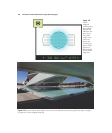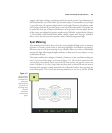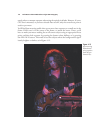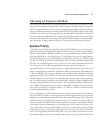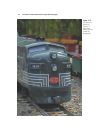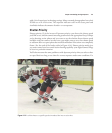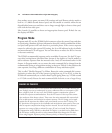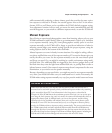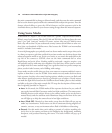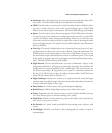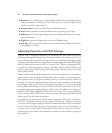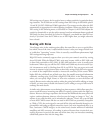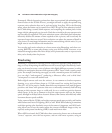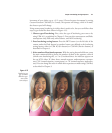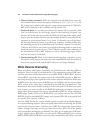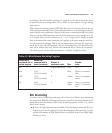
the main command dial to change to Manual mode, and then turn the main command
dial to set the shutter speed, and the sub-command dial to adjust the aperture. Press the
shutter release halfway or press the AE lock button, and the exposure scale in the
viewfinder shows you how far your chosen setting diverges from the metered exposure.
Using Scene Modes
As described in Chapter 2, the D7000 retains the “quickie” exposure modes found in
Nikon’s entry-level cameras (like the D5100 and D3100), but absent from the com-
pany’s “pro” and “semi-pro” models. Of course, anyone who uses a D7000 for more
than a day will see that it is just as advanced as many cameras (from Nikon or other ven-
dors) that cost hundreds of dollars more. But because the D7000 is an intermediate
model, it includes Scene modes.
As an avid photographer, you probably won’t use Scene modes much, except when you’re
in a hurry to capture a grab shot and don’t have time to make any decisions about what
advanced exposure mode to use. You’re on a beach, so you rotate the mode dial on the
top left of the camera to SCENE, then use the main command dial to select
Beach/Snow, and you’re all set. Nothing could be easier and—surprise, surprise—you
will probably end up with some nice snapshots. You don’t have all the creative control
you might need for a more studied image, but a grab shot that’s not perfect trumps any
photo you don’t take because you’re fiddling with settings.
Scene modes are also useful when you loan your camera to someone and don’t want to
explain to them how to use the D7000. Scene modes not only make decisions about
basic exposure, but they select some focusing options, whether or not to use flash, and
what shutter speeds/apertures are best for a particular type of subject. Nearly anyone
can make the right choice based on the 19 different Scene modes (plus two Auto modes)
available at the spin of the main control dial. I’ll recap the descriptions of these modes
that I originally provided in Chapter 2:
■ Auto. In this mode, the D7000 makes all the exposure decisions for you, and will
pop up the internal flash if necessary under low-light conditions. The camera auto-
matically focuses on the subject closest to the camera (unless you’ve set the lens to
manual focus), and the autofocus assist illuminator lamp on the front of the cam-
era will light up to help the camera focus in low-light conditions.
■ Auto (Flash Off). Identical to Auto mode, except that the flash will not pop up
under any circumstances. You’d want to use this in a museum, during religious cer-
emonies, concerts, or any environment where flash is forbidden or distracting.
■ Portrait. Use this mode when you’re taking a portrait of a subject standing rela-
tively close to the camera and want to de-emphasize the background, maximize
sharpness, and produce flattering skin tones. The built-in flash will pop up if
needed.
David Busch’s Nikon D7000 Guide to Digital SLR Photography116



